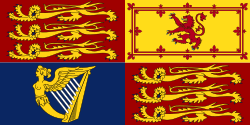Havering Palace

Havering Palace was one of the many royal residences in England. It was located in the village of Havering-atte-Bower in what is now the London Borough of Havering. It stood just to the north and west of the existing parish church of St John the Evangelist, which was built on the site of one of the palace’s chapels.
History
The earliest references to a royal demesne at Havering date from the time of Edward the Confessor, and although there is no definite proof that he ever visited it, the strength of local legend suggests he did. It was definitely a royal manor by the Norman Conquest when it passed to William the Conqueror. The royal manor also gave the surrounding area the designation of the Royal Liberty of Havering, which gave those living in the area freedom from taxation and other benefits. The manor was granted to Queen Eleanor by Henry III in 1262 and thereafter usually belonged to the queen consort or dowager until the death of Jane Seymour in 1537,[1] leading to the 'Bower' portion of the village's place name.
A house was already there by the 12th Century, and extensive building took place in the 13th Century. Many royalty from then on are recorded as having stayed there, James I being the last to do so regularly. In 1358 Edward III held a 5-month Marshalsea Court at Havering Palace for locals to air their personal grievances, an unusual act since the Marshalsea Court was reserved for the royal household. By the 17th Century it was in poor condition, and Charles I was the last monarch to stay there in 1638. After the Restoration the house (by then called Havering House) was occupied by the Earl of Lindsey but despite evidence of considerable sums of money being spent on repairs, it became vacant some time between 1686 and 1719, when it was reported to be in ruins. Stone from it may subsequently have been used for other local buildings, as by 1816 no walls were visible above ground.[1]
Description
At its greatest extent before decay set in, most of the palace dated from the major building works of the 13th century with a newer block built in 1576-7. The plan was irregular, containing a great chamber, royal apartments, two chapels, and various out-buildings.[1] The parkland surrounding it covered most of the former parish of Havering-atte-Bower west of the main road (now North Road) and was much more extensive than the current Havering Country Park, which covers the part of the former park adjoining the site of the palace.
Residents
Royalty and other famous people who have resided in the palace at some point include:
- Edward the Confessor
- Harold Godwinson
- William I
- Henry II
- John
- Eleanor of Aquitaine
- Edward III
- Joan of Navarre, Queen of England, who died at the palace in 1437
- Edward IV
- Henry VIII
- Mary I
- Elizabeth I
- Charles I, the last monarch to reside at Havering
- Marie de Medici, the Queen of France and mother-in-law to Charles I, although she took a look at the crumbling palace, she decided to rest at Gidea Hall, Romford a few miles south.
- Richard Cromwell
- Robert Bertie, 3rd Earl of Lindsey
References
- 1 2 3 A History of the County of Essex: Volume 7 (1978), pp. 9-17, Parishes: Havering-atte-Bower . Date accessed: Wednesday, October 10, 2007
Coordinates: 51°36′54″N 0°10′37″E / 51.61490°N 0.17685°E

.svg.png)